英语报刊选读4-21Lesson 8
- 格式:ppt
- 大小:1.93 MB
- 文档页数:56
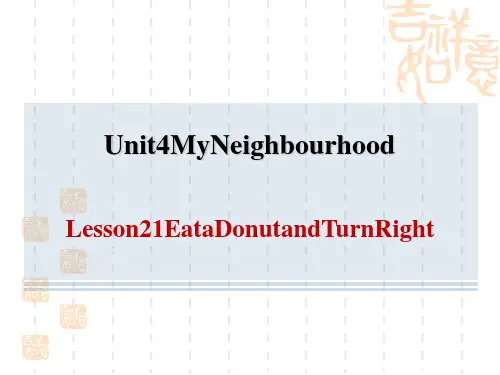
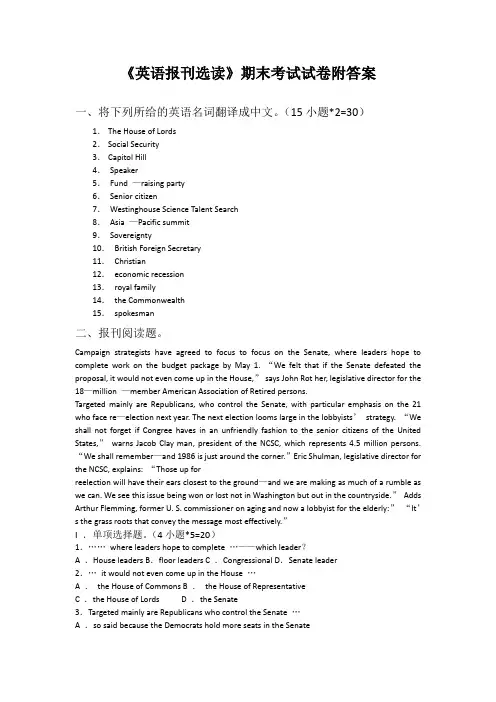
《英语报刊选读》期末考试试卷附答案一、将下列所给的英语名词翻译成中文。
(15小题*2=30)1.The House of Lords2.Social Security3.Capitol Hill4.Speaker5.Fund —raising party6.Senior citizen7.Westinghouse Science Talent Search8.Asia —Pacific summit9.Sovereignty10.British Foreign Secretary11.Christian12.economic recession13.royal family14.the Commonwealth15.spokesman二、报刊阅读题。
Campaign strategists have agreed to focus to focus on the Senate, where leaders hope to complete work on the budget package by May 1. “We felt that if the Senate defeated the proposal, it would not even come up in the House,”says John Rot her, legislative director for the 18—million —member American Association of Retired persons.Targeted mainly are Republicans, who control the Senate, with particular emphasis on the 21 who face re—election next year. The next election looms large in the lobbyists’strategy. “We shall not forget if Congree haves in an unfriendly fashion to the senior citizens of the United States,”warns Jacob Clay man, president of the NCSC, which represents 4.5 million persons. “We shall remember—and 1986 is just around the corner.”Eric Shulman, legislative director for the NCSC, explains: “Those up forreelection will have their ears closest to the ground—and we are making as much of a rumble as we can. We see this issue being won or lost not in Washington but out in the countryside.”Adds Arthur Flemming, former U. S. commissioner on aging and now a lobbyist for the elderly:”“It’s the grass roots that convey the message most effectively.”I .单项选择题。
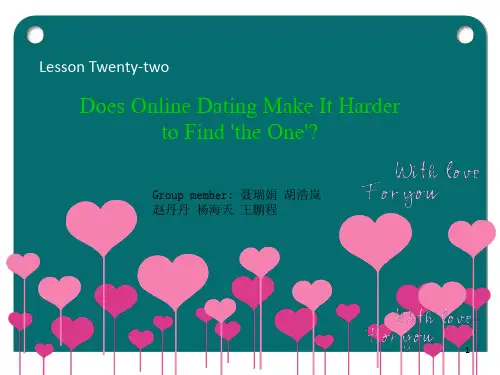
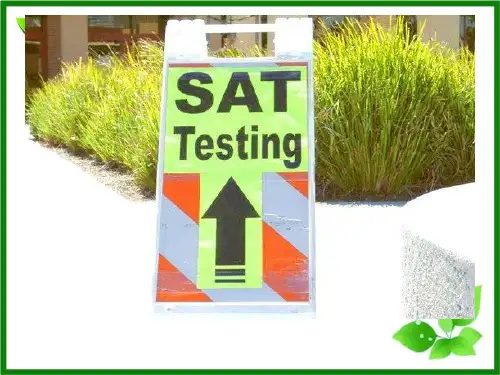
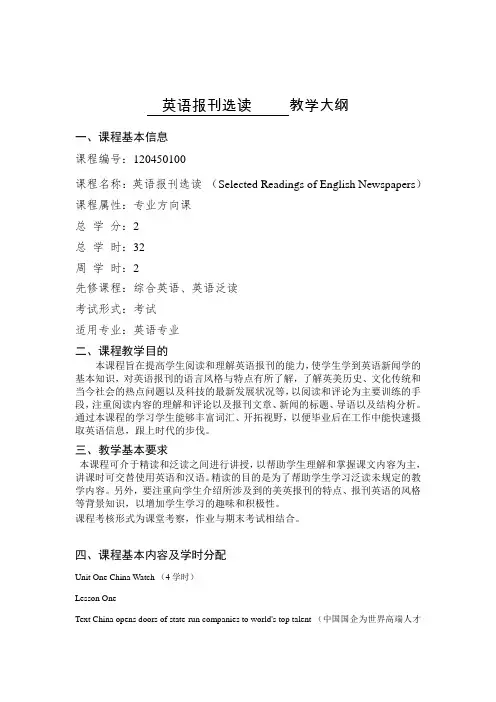
一、课程基本信息课程编号:120450100课程名称:英语报刊选读(Selected Readings of English Newspapers)课程属性:专业方向课总学分:2总学时:32周学时:2先修课程:综合英语、英语泛读考试形式:考试适用专业:英语专业二、课程教学目的本课程旨在提高学生阅读和理解英语报刊的能力,使学生学到英语新闻学的基本知识,对英语报刊的语言风格与特点有所了解,了解英美历史、文化传统和当今社会的热点问题以及科技的最新发展状况等,以阅读和评论为主要训练的手段,注重阅读内容的理解和评论以及报刊文章、新闻的标题、导语以及结构分析。
通过本课程的学习学生能够丰富词汇、开拓视野,以便毕业后在工作中能快速摄取英语信息,跟上时代的步伐。
三、教学基本要求本课程可介于精读和泛读之间进行讲授,以帮助学生理解和掌握课文内容为主,讲课时可交替使用英语和汉语。
精读的目的是为了帮助学生学习泛读未规定的教学内容。
另外,要注重向学生介绍所涉及到的美英报刊的特点、报刊英语的风格等背景知识,以增加学生学习的趣味和积极性。
课程考核形式为课堂考察,作业与期末考试相结合。
四、课程基本内容及学时分配Unit One China Watch (4学时)Lesson OneText China opens doors of state-run companies to world's top talent (中国国企为世界高端人才敞开大门)(The Washington Post, November 16, 2011)新闻写作何谓NewsLesson TwoText An American in Beijing(中国经济迅猛发展,留学生蜂拥而至)(Time, April 4,2008)语言解说 PresenceLesson ThreeText Tiger Mom ... Meet Panda Dad(熊猫爸爸挑战虎妈育儿经)(The Wall Street Journal, March 29,2011)新闻写作新闻体裁Unit Two United States (Ⅰ)(4学时)Lesson FourText Is an Ivy League Diploma Worth It?(上常春藤名校,值吗?)(The Wall Street Journal, November 8,2011)读报知识 Ivy League & Seven Sisters CollegesLesson FiveText Debt Burden Alters Outlook for US Graduates(求学负债:美国毕业生前景堪忧)(The Financial Times, June 1,2012)学习方法读懂标题(I)Lesson SixText The Evolution Wars(进化论与上帝造人说之争)(Time, August 15, 2005)读报知识宗教Unit Three United States (Ⅱ)(4学时)Lesson SevenText Obama Wins a Second Term as U.S. President(奥巴马连任总统:任重道远)(The Washington Post, November 7,2012)读报知识美国总统选举Lesson EightText The Economy Sucks. But Is It' 92 Redux?(经济不振,难道08年大选是92年的翻版吗?)(Newsweek, January 21, 2008)语言解说 Stupid和Technical(ly)Lesson NineText Five myths about the American dream(对美国梦的种种困感)(The Washington Post, Jan 6,2012)新闻写作导语(Lead)Lesson TenText Is America-s new declinism for real?(美国是真的衰落了吗?)(Financial Times, November 24, 2008)语言解说 EstablishmentUnit Four United States(Ⅲ)(4学时)Unit Five Britain (4学时)Unit Six The World (4学时)Unit Seven Society (4学时)Unit Eight Business and Science (2学时)Unit Nine Sports and Entertainment(2学时)五、教材及主要参考书目郭影平《最新报刊英语阅读》东南大学出版社 2010马建国《英文报刊导读》,外语教学与研究出版社,2002周学艺《英美报刊文章选读(精选本)》,北京大学出版社1997周学艺《英美报刊文章选读(精选本)学习辅导》,北京大学出版社1997端木义万,《英美报刊阅读教程》南京大学出版社,1997。
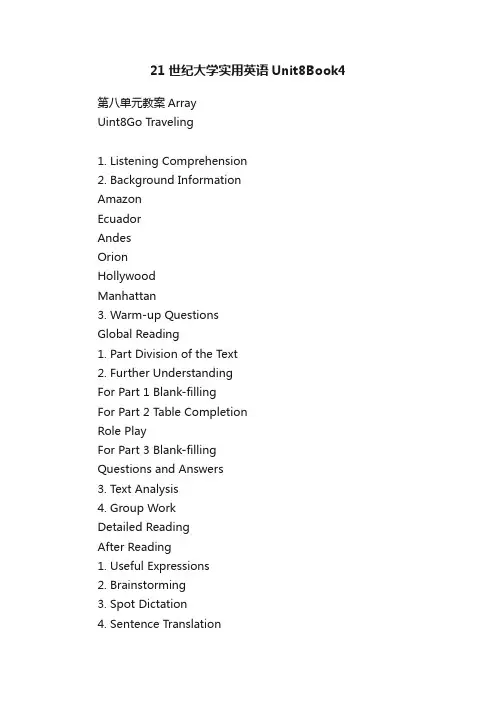
21世纪大学实用英语Unit8Book4第八单元教案ArrayUint8Go Traveling1. Listening Comprehension2. Background InformationAmazonEcuadorAndesOrionHollywoodManhattan3. Warm-up QuestionsGlobal Reading1. Part Division of the Text2. Further UnderstandingFor Part 1 Blank-fillingFor Part 2 Table CompletionRole PlayFor Part 3 Blank-fillingQuestions and Answers3. Text Analysis4. Group WorkDetailed ReadingAfter Reading1. Useful Expressions2. Brainstorming3. Spot Dictation4. Sentence Translation5. Writing Practice6. Talk about the Pictures7. Role Play8. Proverbs and Quotations Supplementary Reading1. Culture Notes2. Reading3. Comprehension Task1. Listening Comprehension1. Where is the author living?(=the Niagara region)2. What was he/she surprised to learn when he/she went to university in T oronto?(=Niagara is one of the top crop producers in not only Ontario, but also Canada. And many of the people I met who were from Toronto had never seen a farm before, or enjoyed the small pleasures of picking their own fruit or going for hikes in scenic areas.)3. How did he/she feel when he/she decided to stop by and take a look at the fallsthrough the eyes of a tourist?(=awed, mystified, a sense of wonder)4. Have you ever had the same kind of experience as the author did?(This is an open-ended question.)We live busy lives with so little time to enjoy the world around us that oftentimes we almost forget it is there.Living in the Niagara region, an area that has so much to offer both scenically and historically, we forget about the diversity of nature and the fact that not everyone lives as we do.Going to university in Toronto this year, I was surprised tolearn that Niagara is one of the top crop producers in not only Ontario, but also Canada. I was even more surprised that many of the people I met who were from T oronto had never seen a farm before, or enjoyed the small pleasures of picking their own fruit or going for hikes in scenic areas. I realized that I was lucky to have experienced both the urban and rural life.Intrigued by the question of how I felt about living so close to Niagara Falls, I decided to stop by after work one night and really look at them. I felt as though I was really seeing the falls for the first time, and they truly were everything that the tourists had promised. Staring into the never-ending cascades of water, I was mystified by it all.Here I was, standing at the top of such a glorious sight that I had seen so many times before, but for the first time in my life, I was truly seeing it the way that it was meant to be seen; through the eyes of a tourist.2. Background InformationAmazon (river)(Questions:1. What do you know about Amazon?2. According to the two pictures, describe the geographic location of Amazon. )(文字材料)Amazon river in northern South America, largely in Brazil, ranked as the largest in the world in terms of watershed area, number of tributaries, and volume of water discharged.Measuring 6,400 km (4,000 mi) from source to mouth, it is second in length only to the Nile among the rivers of the world. With its hundreds of tributaries, the Amazon drains a territory of more than 6 million sq km (2.3 million sq mi), roughly half ofwhich is in Brazil; the rest is in Peru, Ecuador, Bolivia, and Venezuela. It is estimated that the Amazon discharges between 34 million and 121 million liters (9 million and 32 million gallons) of water per second and deposits a daily average of 3 million tons of sediment near its mouth. The annual outflow from the river accounts for one-fifth of all the fresh water that drains into the oceans of the world. The outpouring of water and sediment is so vast that the salt content and color of the Atlantic Ocean are altered for a distance of about 320 km (about 200 mi) from the mouth of the river.EcuadorEcuador republic in northwestern South America, bounded by Colombia on the north, by Peru on the east and south, and by the Pacific Ocean on the west. The country also includes the Galápagos Islands (Colón Archipelago) in the Pacific, about 965 km (about 600 mi) west of the mainland. Ecuador straddles the equator (Ecuador is the Spanish word for “equator”) and has an area of 272,045 sq km (105,037 sq mi). Quito is the country’s capital.Ecuador has a diverse population composed of people of European, Native American, and African descent. The majority are mestizos, individuals of mixed European and Native American ancestry. Most of the Native Americans live in poverty in the highlands region, where a small elite of European descent controls most of the land and wealth.Ecuador was a Spanish colony until 1822, when independence forces won a decisive victory over Spain. Ecuador has had a democratically elected government since 1979, but historically the government has alternated between civilian rule and military dictatorship. Most political conflicts involvedsquabbles among groups within the upper classes who controlled the nation’s wealth.Andes(Questions:According to the picture, describe the geographic situation of Andes. )(文字材料)The Andes are the principal mountains of South America and one of the greatest mountain systems of the world. The Andes include some of the world’s highest peaks. More than 50 of them soar higher than 6,100 m (20,000 ft) above sea level. Only the Himalayas of south central Asia are higher. The lofty plateaus and high mountain valleys of the Andes contain some of the highest permanent human settlements in the world. The Andes are the longest system of high mountain ranges on earth. They extend for more than 8000 km (5000 mi) in a narrow belt along the western edge of the South American continent, from the coast of the Caribbean Sea in the north to the island of Tierra del Fuego in the extreme south. Along almost its entire length, the Andes rise abruptly from the Pacific coast. The mountains reach into seven countries: Venezuela, Colombia,Ecuador, Peru, Bolivia, Chile, and Argentina.OrionOrion (astronomy), constellation located on the celestial equator east of Taurus. It is an oblong configuration with three stars in line near its center. It is represented on pictorial charts as the figure of Orion, the hunter in Greek mythology, standing with uplifted club. Three bright stars represent his belt and three fainter stars aligned south of the belt represent his sword. A lpha (α) Orionis, or Betelgeuse, is located in the left corner of theoblong, corresponding to Orion's shoulder. Beta (β) Orionis, or Rigel, is diagonally opposite Betelgeuse. A nebula surrounding the three stars marking Orion's sword is one of the most conspicuous bright nebulas in the heavens.HollywoodDictationListen to the passage and fill in the blanks with the missing words.Hollywood (California), unincorporated district in the northwestern part of the city of Los Angeles, southwestern California, famed as a center of the motion picture industry in the United States. It is also a major center of the U.S. television industry. The main thoroughfares, Sunset and Hollywood boulevards and Vine St., contain well-known restaurants, nightclubs, and broadcasting studios. The Hollywood Bowl, a natural amphitheater in the Hollywood Hills, is the site of numerous cultural events. The community was laid out in the late 1880s, after a real estate developer named Harvey Wilcox registered his 120-acre citrus ranch as Hollywood on February 1st, 1887, and started selling subdivisions of the property. Incorporated in 1903, it merged with Los Angeles in 1910. The first movie studio was established here in about 1911.ManhattanManhattan (New York), borough of New York City, coextensive with New York County, southeastern New York, at the head of Upper New York Bay. The main economic hub of New York City, Manhattan is one of the world’s leading co mmerci al, financial, cultural, manufacturing, medical, and tourist centers. Manhattan Island, which makes up almost all of the borough, is bounded on the north and northeast by Spuyten Duyvil Creekand the Harlem River, which separate it from the borough of the Bronx; on the east by the East River, which separates it from the boroughs of Queens and Brooklyn; on the south by Upper New York Bay; and on the west by the Hudson River, which separates it from New Jersey. The borough, about 80 sq km (about 31 sq mi) in area, also encompasses a small exclave (Marble Hill) on the Bronx mainland; several islands in the East River, including Franklin D. Roosevelt Island (the site of a large modern housing complex), Randalls Island, and Wards Island; and Governors Island in U pper New York Bay.3. Warm-up Questions1. What are some distinctive features of an out-of-the-way, inaccessible place suchas a jungle, desert, or remote mountainous area?2. Why would such a place appeal to many people today?3. What are the characteristics of those people who are attracted to such places?4. What do you think San Mao’s travel through the Sahara Desert?5. Have you ever been to such a place? If yes, say something about your travel.6. If you have both time and money, what places would you like to visit most? Why? Global Reading1. Part Division of the Text2. Further UnderstandingFor Part 1 Blank-filling1. What happens in this part.When: in the middle of the night; It was February, the middle of summer.Where: the Napo River in the Ecuadorian jungle; on the headwaters of the Amazon Who: three North Americans, four EcuadoriansWhat: Like any out-of-the-way place, the Napo River in the Ecuadorian jungle seems real enough when you are there, even central.Why: Out of the way of what?2. Find out the sensory impressions in this part.Hearing:1. A nightjar in deep-leaved shadow called three long notes, and hushed.2. In the thatch house across the clearing behind us came the sound of arecorder, playing a tune that twined over the village clearing, muted ourtalk on the bank side, and wandered over the river, dissolving downstream.Feeling: This will do, I thought. This will do, for a weekend, or a season, or a home.Smelling: Each breath of night smelled sweet.Tasting: cool drinksSeeing: idly watching a hand-sized tarantula seize mothsFor Part 21. Table CompletionHere the author handles the changes in time and place in a smooth way. Fill in the2. Role PlayFour students form a group: one plays as the author, one as the freelance writer from Manhattan and the other two asEcuadorians. Each talks about his or her life.Pay attention to the sharp contrast of the two different kinds of life.For Part 31. Blank-fillingFind out the sensory impressions in Part III.Hearing: …the u nseen birds of twilight wistful, catching the heart.Feeling: What is there is interesting.Smelling: sweet airTasting: …eat chicken …, together with rice, onions and heaps of fruit.Seeing: Parrots in flocks dart in and out of the light.2. Questions and Answers1. What is the point of going to the Napo River in Ecuador according to the author?(It is simply to see what is there. We are here on the planet only once, and mightas well get a feel for the place.)2. What did they find along the Napo River?(parrots in flocks, anacondas, gray strips of sandbar, palm-thatch shelters)3. Can you imagine the Indian’s life and why did they get up at three?(They were getting warm.)4. What did the tourist group see inside the jungle?(the trees, butterflies, a swath of ants)5. What animals did they see while canoeing on one of the lakes?(herons, kingfishers, cuckoos, great turkey like birds, hawks,turtle)6. What did they eat that night in the village? And what did they see there?(They ate chicken, together with rice, onions and heaps of fruit.They saw the sunset, two nuns and children.)7. What message does the author want to convey to the reader by her descriptionof what was going on in the evening in that village?(It is not out of the way. It is in the way.)3. Text Analysis“Out of the way of what?” asks the writer at the beginning of the text while talking about the Napo River. However, she finally comes to the conclusion that “it is not out of the way”. All through the text there is overall coherence. There is an echo—“It would be worth it”, “The Napo River: it is not out of the way. It is in the way”.SkimmingMake a list of at least eight things that the author finds so attractive about life in the jungle.1)________________________________________________2)________________________________________________3)_________________________________________________4)_________________________________________________5)________________________________________________6)________________________________________________7)________________________________________________8)________________________________________________4. Group WorkStudents move around the classroom, find a partner, reciteor read aloud to each other their favorite sentences from the text, explain why, then move on to find another partner. By thus doing you can appreciate the aesthetic side of English.Detailed Reading1.Difficult SentencesOut of the way of what? … Out of the way of human life, tenderness, or the glance of heaven?What role does the sentence play?(=In the first paragraph the author asks a question to arouse the readers’ interest and point out the main idea of the whole essay. This is a good way to begin and to develop an essay.) Beneath us the brown Napo River was rising, in all silence; it coiled up the sandy bank and tangled its foam in vines that trailed from the forest and roots that looped the shore.Translate the sentence and enjoy the aesthetic side of English.(=在我们下方,褐黄色的纳波河水正在涨潮。
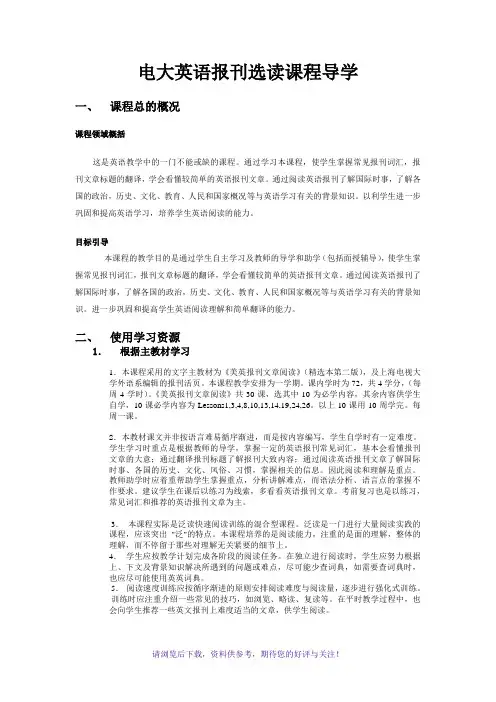
电大英语报刊选读课程导学一、课程总的概况课程领域概括这是英语教学中的一门不能或缺的课程。
通过学习本课程,使学生掌握常见报刊词汇,报刊文章标题的翻译,学会看懂较简单的英语报刊文章。
通过阅读英语报刊了解国际时事,了解各国的政治,历史、文化、教育、人民和国家概况等与英语学习有关的背景知识。
以利学生进一步巩固和提高英语学习,培养学生英语阅读的能力。
目标引导本课程的教学目的是通过学生自主学习及教师的导学和助学(包括面授辅导),使学生掌握常见报刊词汇,报刊文章标题的翻译,学会看懂较简单的英语报刊文章。
通过阅读英语报刊了解国际时事,了解各国的政治,历史、文化、教育、人民和国家概况等与英语学习有关的背景知识。
进一步巩固和提高学生英语阅读理解和简单翻译的能力。
二、使用学习资源1.根据主教材学习1.本课程采用的文字主教材为《美英报刊文章阅读》(精选本第二版),及上海电视大学外语系编辑的报刊活页。
本课程教学安排为一学期。
课内学时为72,共4学分,(每周4学时)。
《美英报刊文章阅读》共30课,选其中10为必学内容,其余内容供学生自学,10课必学内容为Lessons1,3,4,8,10,13,14,19,24,26。
以上10课用10周学完。
每周一课。
2.本教材课文并非按语言难易循序渐进,而是按内容编写,学生自学时有一定难度。
学生学习时重点是根据教师的导学,掌握一定的英语报刊常见词汇,基本会看懂报刊文章的大意;通过翻译报刊标题了解报刊大致内容;通过阅读英语报刊文章了解国际时事、各国的历史、文化、风俗、习惯,掌握相关的信息。
因此阅读和理解是重点。
教师助学时应着重帮助学生掌握重点,分析讲解难点,而语法分析、语言点的掌握不作要求。
建议学生在课后以练习为线索,多看看英语报刊文章。
考前复习也是以练习,常见词汇和推荐的英语报刊文章为主。
3.本课程实际是泛读快速阅读训练的混合型课程。
泛读是一门进行大量阅读实践的课程,应该突出"泛"的特点。
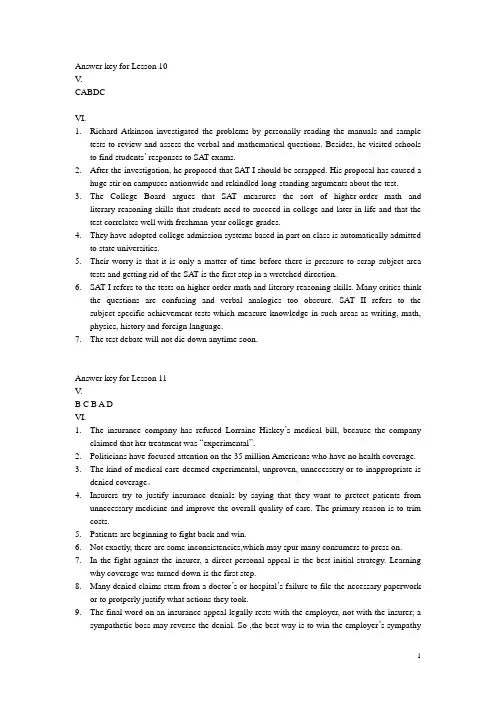
Answer key for Lesson 10V.CABDCVI.1.Richard Atkinson investigated the problems by personally reading the manuals and sampletests to review and assess the verbal and mathematical questions. Besides, he visited schools to find students’ responses to SAT exams.2.After the investigation, he proposed that SAT I should be scrapped. His proposal has caused ahuge stir on campuses nationwide and rekindled long-standing arguments about the test.3.The College Board argues that SAT measures the sort of higher-order math andliterary-reasoning skills that students need to succeed in college and later in life and that the test correlates well with freshman-year college grades.4.They have adopted college admission systems based in part on class is automatically admittedto state universities.5.Their worry is that it is only a matter of time before there is pressure to scrap subject-areatests and getting rid of the SAT is the first step in a wretched direction.6.SAT I refers to the tests on higher-order math and literary-reasoning skills. Many critics thinkthe questions are confusing and verbal analogies too obscure. SAT II refers to the subject-specific achievement tests which measure knowledge in such areas as writing, math, physics, history and foreign language.7.The test debate will not die down anytime soon.Answer key for Lesson 11V.B C B A DVI.1.The insurance company has refused Lorraine Hiskey’s medical bill, because the companyclaimed that her treatment was “experimental”.2.Politicians have focused attention on the 35 million Americans who have no health coverage.3.The kind of medical care deemed experimental, unproven, unnecessery or to inappropriate isdenied coverage。
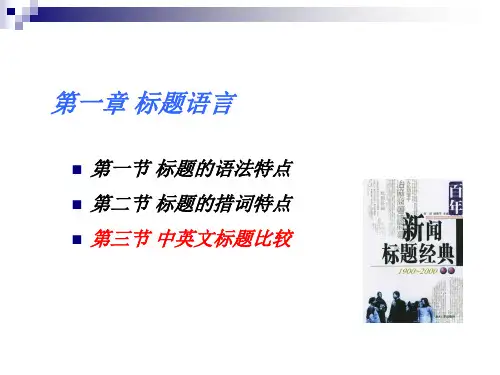
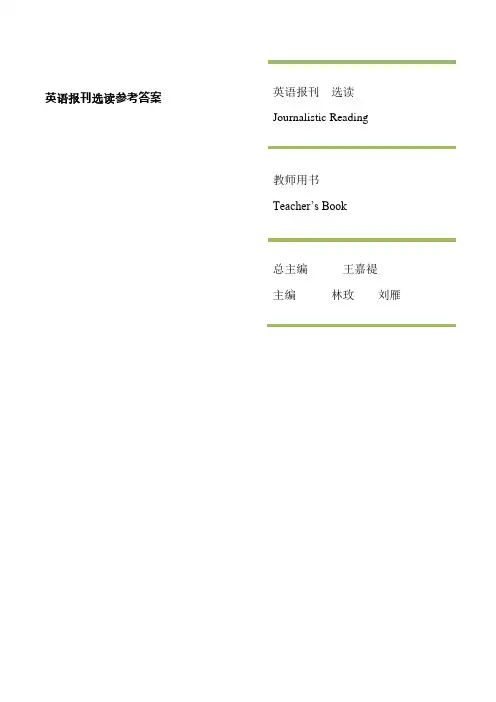
英语报刊选读参考答案英语报刊选读Journalistic Reading教师用书Teacher’s Book总主编王嘉褆主编林玫刘雁BOOK ONE (2)UNIT 1 Campus (2)UNIT 2 Entertainment (5)UNIT 3 Entertainment (9)UNIT 4 Food (12)UNIT 5 Crime (15)UNIT 6 Disaster (19)UNIT 7 Sports (23)UNIT 8 Art (28)UNIT 9 Economy (31)UNIT 10 Ecology (36)UNIT 11 Health (39)UNIT12 Automobile & Driving (43)UNIT 13 Quality problems (48)UNIT 14 Shopping (52)UNIT 15 Gun control (56)UNIT 16 Psychology (59)BOOK ONEUNIT 1 CampusI.Vocabulary Builder1.Definition1)chaotic: extremely disorganized; badly organized; be in mess2)primary: main; most important; key; major; chief; prime; principal3)seduce: attract; tempt4)highlight: the most important, interesting, or enjoyable part ofsomething such as a holiday, performance, or sports competition5)reluctant: unwilling6)compelling: very interesting or exciting, so that you have to payattention7)reveal: show; indicate8)mainstream: accepted by or involving most people in a society;normal; ordinary9)critical: important; crucial10)evolution: a long, gradual process during which something developsand changes, usually becoming more advanced; a gradual change and development2. Terms translation1) a bipartisan consensus2)high school diploma3)drop-out rate4)college wage premium5)the K-12 system6)more academically rigorous7)well-rounded citizens8)certification tests9)career and technical education3. Blank filling1) persevered 2) persisted 3) insisted 4) insisted 5) persevere6) agony 7) adversity 8) torment 9) plight 10) assure/reassure11) insure/ensure 12) insure 13) insure/ensure 14) assured/reassuredII.Translation1.选择圣路易斯的华盛顿大学是个不错的决定,但真正让我享受到理想大学生活的,(不是大学本身)是我到了大学后作的一些决定。
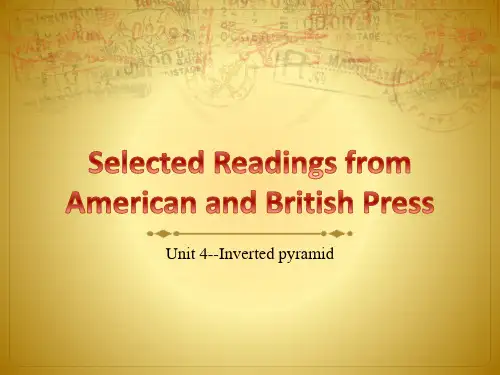
Unit One★Why is newspaper reading an important class?Reading is a skill-needs practice, has strategies to improve it,Newspapers are authentic source-cultural insight into different countriesThey have short articles-the info is usually condensed, concise, and creatively communicated They can help keep us informed about what is happening in the worldThey extend our knowledge/ New Information- a wide variety of subjects and interestsThey reflect language change★Why are newspapers valuable?A newspaper informs by supplying facts, figures, charts, maps, photos and illustrations.A newspaper educates, going beyond the basic facts to in-depth analysis in opinion pieces, feature stories, columns and editorials.A newspaper entertains with humorous columns, leisure features, comics and puzzles.A newspaper provides a print marketplace for advertisers and prospective customers.A newspaper provides a record for historians and members of a community researching local history.Unit Two★Classification of newspapers1.Newspapers concerning business经济类报刊:Business-oriented;Financial/business news;Analysis of business topics;Wall Street Journal (U.S)Financial Times(UK)prehensive newspapers 综合性报刊:A variety of topics such as political news; sports news; science and technology;Also include business news, however lack of detailed analysis of business topics;The New York Times; Washington Post; USA today(U.S) and etc;The Times; the Daily Telegraph; Guardian (UK) and etc;★Major magazines in America:Time, Newsweek,US News and World Report,Readers’ Digest,Fortune,★Major magazines in Britain:The Economist,New Statesmen,★Major newspapers in America:Wall Street Journal,USA today,Los Angles Times, New York Times,Washington Post,The Christian Science Monitor,International Herald Tribune,★Major newspapers in Britain:Financial Times,Daily Telegraph,Guardian,Times,The Observer,Unit Three★Design of layoutFront Page & Front page termsIn a newspaper, the most important page is the front page since it is designed to arouse the reader’s interest. Editors work hard on front page arrangement and try to create their own characteristic styles.★Technical Terms of Newspaper EnglishBanner headline-Look for the top story of the day;Bold headlines-Look for the other important news stories of the day;Inside/keys-Look for the important news stories on the otherpages;Sections-your interested news;Headline;Lead;(Headline\banner headline\bold headline\byline\cutline\dateline;News service;Lead\subject\news story(main body))Unit Four★There are three main types of journalismStraight news/spot news;Feature (news);Editorial & commentary/opinion;★Component of straight newsStraight news is mainly composed of the following five parts:1.Headline(标题)Headline is the first thing that catches your eye. It tries to tell the whole story in one sentence and then a smaller headline(sub-headline) tells more details of what happened.2.Sub-headline(副标题)3.Dateline(电头/日期行:日期,地点,通讯社)Dateline comes after sub-headline. It consists of three parts:1). the place where the news story was reported;2). The date when the news story was reported;3). the news agency;After the date are the letters standing for the news agencies(通讯社)a.AP(Associated Press) 美联社b.PA(press Association) 英国报纸联合社c. REUTER(Reuter’s News Agency)法国路透社d. BUP(British United Press, Ltd)英国合众社4.News lead(导语)Lead is the first paragraph of the whole news items;Lead tells all the important facts of the whole story in a content-packed sentence.It tells “five wives”—who, what, where, when, why and how about the event.Lead is also named as summary lead for it gives a comprehensive summary of news items5.The body of News story(正文)The body of news stories: The rest of the news item tells the details about the event, such as background, comments and etc.★Features of organizational structureSummary lead is commonly used in a straight news story, which gives a comprehensive summary of news items;A straight news story follows the inverted pyramid structure(the most important information comes first in the lead and the less important information such as background, comments come later in the body of the news);The lead of a straight news story usually answers five questions- “who”, “what”, “where”, “when”, “why” and“how”;Unit five★Importance and function of headlines:First of all, it summarizes the whole news story in one content-packed sentence so the hurried readers can get the gist of the story at a glance.Secondly, it draws the readers’ attention to the story. In this sense, headl ines are usually attractive so as to catch the readers’ eye.Thirdly, since headlines summarize the whole story, it can help the readers to evaluate the story so as to decide whether or not this news story is worth reading.★Types of newspaper headlines:A. Statement/summary (摘要式) :This kind of headline states the main topic of the whole news story. It is commonly used and is easy to understand. This kind of headline often appears in statement, that’s why it is named as statement sometimes.B. Question (设问式):However, most question headlines are not real questions. They are statements followed by a question mark. The question headline can either suggest a future possibility or some doubt about the truth or accuracy of the story:C. Quotation (引语式):This type of headline simply quotes what one says usually in direct speech so as to make the title vivid and lively. The quotation is usually from the spokesman, the eyewitnesses and the people involved in the news.D. Double headlines (双标题):The double headlines for the same news story are often used for important events:★Language features of newspaper headlinesLexical features:Preference for short & simple words-headline words ;Wide Use of Abbreviations &Acronyms Grammatical features:1.Frequent omission of function words: in particular, articles, conjunctions, prepositions, auxiliary verbs and pronouns:(1) Articles, (2) Auxiliaries,(3) The conjunction “and” is usually replaced witha comma,(4) The verb “say”, “said” are sometimes replaced with a colon “:” or quotation marks2. Simplification of tense:(1) Wide use of the simple present tense to describe something happening in the past as well as in the present,(2) The future tense is expressed with the infinitive to replace “will”, “shall”.Rhetorical features:Idioms are frequently used in English newspaper headlines so as to achieve vividness and meanwhile appeal to readers ;Slang;Colloquialism;proverbUnit Six★What is news lead?News lead refers to the first paragraph in a news story.★What is the language feature of news lead?Lead, like all English sentences is built around the subject and main verb.★How to understand news lead?As a result, if we can identify the subject and main verb, we will have a good understanding of news lead and the whole story.★How to understand news lead??Identify the subject and main verb first!!★What is prediction?Prediction means guessing what will happen next in the story.★Why should readers make prediction?It involves the readers in active interaction with the text by making them think about what they have read and what they will read next.★How to make prediction?Readers can make prediction based on the picture, title and the first paragraph; for instance, if you are reading a story about a murder, you can expect to find the answers to questions such as:Who was murdered?What was the reason for the murder?Has the murderer been caught? Readers can make prediction based on the picture, title and the first paragraph.Unit Seven★The body of news itemsWhat is it?The rest of news stories apart from news lead!It usually begins from 2nd paragraph of each news story!★Features of the body of news storiesImportant facts that the writer was unable to include in the lead;Specific details to answer readers’ questions;Statements and opinions by people involved in the story or by outside observers;Background information;New, but less important facts;It might be cut and omitted whenever there is no enough space for it.Unit Eight★Language features of news1.Emergence of news affixes and words: words concerning science and technology,words concerning politics, newly-coined words concerning other fields,2. Extension of words’ meanings: to borrow words from every work of life and extend its meaning.Words from the military field,3. Use of Euphemism:The substitution of an agreeable or inoffensive expression for one that suggests something unpleasant.e of metonymy: the substitution of the name of one thing for that of another closely associated with it.1) the name of an animal is borrowed to substitute a person or an organization.2) the name of a street or a building is used to stand for a well-known establishment or an office, which is located there.3) a well-known person is used to refer to something or somebody sharing the same feature.Unit Nine★Facts vs. opinionFactsA newspaper's primary purpose is to provide reliable information to its readers. To do so, a reporter must let the facts speak for themselves, must convey information fairly.?OpinionHowever, journalists all have their own social, political, economic and cultural background and thus tend to serve the interests of their own nations. Opinions and ideas do have a place in newspapers, in particular, on the editorial page for newspapers.★Bias by word choiceThe use of positive or negative words or words with a particular connotation can strongly influence the reader.Bias through statistics & crowd counts,Bias through use of names & titles, Bias through selections and omission,Bias through placement(Readers of papers judge first page stories to be more significant than those buried in the back. Where a story is placed, therefore, influences what a reader thinks about its importance.Bias by photos(Some pictures flatter a person, others make the person look unpleasant. Pictures can make a person look good, bad, sick, silly, etc. Which photos a newspaper chooses to run can heavily influence the public's perception of a person or event.) Bias by source control (To detect bias, always consider where the news item "comes from." Is the information supplied by a reporter, an eyewitness, police or fire officials, executives, or elected or appointed government officials?)★How is the source conveyed in news?a,News source is usua lly introduced by:Such verbs as “say”, “reveal”, “announce”, “remark”, “comment”;b. By the phrase “according to”;c. By the following passive constructions:It’s claimed that…★How to read a news story criticallyTip1: detect the words conveying bias:As a critical reader, you should pay attention to such words in news as adjectives, adverbs, nouns and verbs which might convey commendatory(positive) or derogatory(negative) meaning.Tip2: judge the source:As a reader, you must learn to judge whether the source is reliable.Is the source named? The reliability of a story is increased if the source is named since few people want to be known as liars.Where is the reporter? Check the dateline to see where the reporter was in relation to the news he is reporting.Tip3: have your own idea concerning a news storyUnit Ten★Opinion writingOpinion: articles that express the opinion of the newspaper’s editors or publishers; articles that reflect the views of columnists or well-known people; Read like an argumentation;Unlike straight news, they do not simply inform or entertain, but also try to persuade readers to accept W’s opinion;★Opinion writing includes the following major types!!Review;Column;Editorial;Letters to the editor;Editorial cartoons★ReviewReview is a description of books, performance, concerts, films, radio and television programs, lectures and art such as painting, dance and sculpture.Book review,Movie reviewUnit Eleven★What are editorial cartoons?Editorial cartoons are drawings or illustrations in the newspaper to help us think about current issues or to sway us toward the cartoonist’s point of view.★Elements of editorial cartoons:Symbolism: Using known concepts, emblems to represent larger ideas, people, organizations andevents.Dialogue bubbles: Used for speech, usually a circle around the words said by someone in a cartoon.Captions/labels: Used to make clear to readers what people and objects are being represented. Exaggeration/caricature: Emphasizing certain physical features or overstating an aspect of a problem. Many times without exaggeration and caricature, the cartoonist’s opinion might not be clear or the problem might not be obvious.Unit Twleve★The editorial★What is the editorial?articles that express the opinion of the newsp aper’s editors or publishers; Read like an argumentation;Unlike straight news, they do not simply inform or entertain, but also try to persuade readers to accept W’s opinion;★Elements of the editorialprimary purpose: They are intended to argue for or against a position and as well persuade the readers into W’s statement;Rhetorical structure(3 parts):Part I: Introduction paragraph: statement of thesis-put forward directly W’s position/put forward the issue in question;Part II: Body paragraphs: development of argumentsTopic sentence—supporting ideas/details/sub-conclusionPart III: Conclusion paragraph: reinforcement of thesis-sum up his main arguments and restate his position/sum up his main arguments and state his position;★Position of main ideas in the editorialThe main idea/W’s idea of the whole passage often appears in introduction paragraph (1st ) or/and conclusion (last paragraph);The location of the main idea/topic sentence of each paragraph is likely to be at the beginning, or the end of the passage and occasionally in the middle of the paragraph.Step1: Carefully read 1st paragraph and last paragraph for it might contain the main idea of the whole passage;Step2: Carefully read 1st & last sentence of each body paragraph for it might be the topic sentence which contains the main idea of each body paragraph;Step3: After having an understanding of the main idea & organizational structure, you can begin to answer the questions;。
英美报刊选读_课文word整合版Unit2 Gender IssuesMen turn to jobs women usually do 1.HOUSTON - Over the last decade, Americanmen of all backgrounds have begun flocking to fields such as teaching, nursing and waiting tables that have long been the province of women.2."The way I look at it is that anything, basically,that a woman can do, a guy can do," said Miguel Alquicira, who graduated from high school when construction and manufacturing jobs were scarce and became a dental assistant.3.The trend began well before the crash,andappears to be driven by a variety of factors, including financial concerns, quality-of-life issues and a gradual erosion ofg ender stereotypes.4.In interviews, about two dozen men played downthe economic considerations, saying that the stigma associated with choosing such jobs had faded, and that the jobs were appealing not just because they offered stable employment, but because they were more satisfying.5."I.T. is just killing viruses and clearing paperjams all day," said Scott Kearney, 43, who tried information technology and other fields before becoming a nurse in the pediatric intensive care unit at Children's Memorial Hermann Hospital in Houston.6.An analysis of United States census data by TheNew York Times shows that from 2000 to 2010, occupations that are more than 70 percent female accounted for almost a third of all job growth for men, double the share of the previousdecade. 7.That does not mean that men are displacing women - those same jobs accounted for almost two-thirds of women's job growth. But in Texas, for example, the number of men who are registered nurses nearly doubled in that time period.8.The shift includes low-wage jobs as well.Nationally, two-thirds more men were bank tellers, almost twice as many were receptionists and two-thirds more were waiting tables in 2010 than a decade earlier.9.Even more striking is the type of men who aremaking the shift. From 1970 to 1990, according to a study by Mary Gatta, senior scholar at Wider Opportunities for Women, an organization based in Washington, D.C., and Patricia A. Roos, a sociologist at Rutgers University in New Jersey, men who took so-called pink-collar jobs tended to be foreign-born, non-English speakers with low education levels.10.Now, though, the trend has spread among men ofnearly all races and ages, more than a third of whom have a college degree. In fact, the shift is most pronounced among young, white, college-educated men like Charles Reed, a sixth-grade math teacher at Patrick Henry Middle School in Houston.11.Mr. Reed, 25, intended to go to law school after atwo-year stint with Teach for America, a national teacher corps of recent college graduates who spend two years helping under-resourced urban and rural public schools. But Mr. Reed fell in love with teaching. He says the recession had little to do with it, though he believes that, by limiting prospects for new law school graduates, it made his father, a lawyer, more accepting.12.To the extent that the shift to "women's work"has been accelerated by recession, the change may reversewhen the economy recovers. "Are boys today saying, 'I want to grow up and be a nurse?'" asked Heather Boushey, senior economist at the Center for American Progress."Or are they saying, 'I want a job that's stable and recession-proof?'"13.Daniel Wilden, a 26-year-old Army veteran andnursing student, said he had gained respect for nursing when he saw a female medic use a Leatherman tool to save the life of his comrade."She was a beast," he said admiringly.14.More than a few men said their new jobs werefar harder than they imagined. But these men can expect success. Men earn more than women even in female-dominated jobs. And white men in particular who enter those fields easily move up to supervisory positions, a phenomenon known as the glass escalator, said Adia Harvey Wingfield, a sociologist at Georgia State University.15."I hated my job every single day of my life," saidJohn Cook, 55, who got a modest inheritance that let him drop a $150,000-a-year database consultant's job to enter nursing school. 16.His starting salary will be two thirds lower, but database consulting does not typically earn hugs like the one Mr. Cook received from a girl after he took care of her premature baby sister. "It's like, people get paid for doing this kind of stuff?"Mr. Cook said, tears coming to his eyes as he recounted the episode.17.Several men cited the same reasons for seekingout pink-collar work that have drawn women to such careers: less stress and more time at home.At John G. Osborne Elementary School, Adrian Ortiz, 42,joked that he was one of the few Mexicans who made more in his native country, where he was a hard-working lawyer, than he did in the United States as a kindergarten teacher in a bilingual classroom. "Now," he said, "my priorities are family, 100 percent."18.Betsey Stevenson, a labor economist at theUniversity of Pennsylvania, said she was not surprised that changing gender roles at home, where studies show men are shouldering more of the domestic burden, are showing up in career choices. "We tend to study these patterns of what's going on in the family and what's going on in the workplace as separate, but they're very much intertwined," she said. "So as attitudes in the family change, attitudes toward the workplace have changed."19.In a classroom at Houston Community College,Dexter Rodriguez, 35, said his job in tech support had not been threatened by the tough economy. Nonetheless, he said, his family downsized the house, traded the new cars for used ones and began to live off savings, all so Mr.Rodriguez could train for a career he regarded as more exciting.20."I put myself into the recession," he said,"because I wanted to go to nursing school."Unit3 E-CommerceThe Post-Cash Economy1.In London, travelers can buy train tickets withtheir phones - and hold up the phones for the conductor to see. And in Starbucks coffee shops in the United States, customers can wave their phones in front of the cash register and pay for their soy chai lattes.2.Money is not what it used to be, thanks to theInternet. And the pocketbook may soon be destined for the dustbin of history - at least if some technology companies get their way.3.The cellphone increasingly contains theessentials of what we need to make transactions."Identification, payment and personal items," as Hal Varian, the chief economist at Google, pointed out in a new survey conducted by the Pew Research Center in Washington, D.C. "All this will easily fit in your mobile device and will inevitably do so."4.The phone holds and records plenty more vitalinformation: It keeps track of where you are, what you like and who your peers are. That data can all be leveraged to sell you things you never knew you needed.5.The survey, released last month by the PewResearch Center's Internet and American Life Project along with Elon University's Imagining the Internet Center in North Carolina, asked justover 1,000 technologists and social scientists to opine on the future of the wallet in 2020. Nearly two-thirds agreed that "cash and credit cards will have mostly disappeared" and been replaced with "smart" devices able to carry out a transaction.But a third of the survey respondents countered that consumers would fear for the security of transactions over a mobile device and worry about surrendering so much data about their purchasing habits.6.Sometimes, those with fewer options are theones to embrace change the fastest. In Kenya, a service called M-Pesa (pesa is money in Swahili) acts like a banking system for those who may not have a bank account. With a rudimentary cellphone, M-Pesa users can send and receivemoney through a network of money agents, including cellphone shops. And in India, several phone carriers allow their customers to pay utility bills and transfer small amounts of money over their cellphones.7.Several technology companies, big and small,are busy trying to make it easier for us to buy and sell all kinds of things without our wallets. A start-up,WePay, describes itself as a service that allows the smallest merchant - say, a dog walker - to get paid; the company verifies the reputations of payers and sellers by analyzing, among other things, their Facebook accounts. 8. A British start-up, called Blockchain, offers afree iPhone application allowing customers to use a crypto-currency called bitcoins, which users can mint on their computers.9. A company called Square began by offering asmall accessory to enable food cart vendors and other small merchants to accept credit cards on phones and iPads. Square's latest invention allows customers to register an account with Square merchants and pay simply by saying their names. The customer's picture pops up on the merchant's iPad.10.Google Wallet has been designed to sit in yourphone, be linked to your credit card, and let you pay by tapping your phone on a reader, using what is known as near field technology.But Google Wallet works on only four kinds of phones, and not many merchants are equipped for near field technology.11.Meanwhile, PayPal, which allows people tomake payments over the Internet, has quietly begun to persuade its users to turn to their cellphones. PayPal posted about $118 billion in total transactions last year and became thefastest-growing segment of eBay, its parent company.12."The physical wallet, which had no innovationin the last 50 years, will become an artifact,"John J. Donahoe, the chief executive of eBay, told me recently. The wallet would move into the cloud, and ideally, from his perspective, into PayPal. No more would the consumer worry about losing a wallet. Everything, he declared, would be contained within PayPal. It would also enable the company to collect vast amounts of data about customer habits, purchases and budgets.13.Mr. Donahoe said he wanted his company to become "a mall in your pocket."14.I recently described PayPal's plans to AlessandroAcquisti, an economist who studies digital privacy at Carnegie Mellon University in Pittsburgh. Mr. Acquisti smiled. If today all you need to do is enter your phone number and PIN when you visit a store, perhaps tomorrow, he said, that store will be able to detect your phone by its unique identifier. Perhaps, you won't have to shop at all. Your shopping data would be instead collected, analyzed and used to tell you exactly what you need: a motorcycle from Ducati or purple rain boots in the next size for your growing child. Money will be seamlessly taken from your account. A delivery will arrive at your doorstep. "In the future, maybe you won't have to pay," Mr. Acquisti offered, only half in jest."The transaction will be made for you."Unit4Cultural ExchangeAsia’s Endangered Species: the Expat1.Forget expats. Western companies doingbusiness in Asia are now looking to locals to fill the most important jobs in the region.2.Behind the switch, experts say, are severalfactors, including a leveled playing field in which Western companies must approach newly empowered Asian companies and consumers as equals and clients—not just manufacturing partners./doc/2216449449.html,panies now want executives who can securedeals with local businesses and governments without the aid of a translator, and who understand that sitting through a three-hour dinner banquet is often a key part of the negotiating process in Asia, experts say.4.In fact, three out of four senior executives hiredin Asia by multinationals were Asian natives already living in the region, according to a Spencer Stuart analysis of 1,500 placements made from 2005 to 2010. Just 6% were noncitizens from outside of Asia.5."It's a strategic necessity to be integrated in theculture. Otherwise, the time to learn all of it takes forever," said Arie Y. Lewin, a professor of strategy and international business at Duke University's Fuqua School of Business. He adds that locals may better navigate a business culture where copycats and competitors often play bydifferent rules.6.What's more, a failed expatriate hire can be acostly mistake and slow a firm's progress in the region, said Phil Johnston, a managing director at recruiter Spencer Stuart.7.To help companies fill Asia-based executiveroles, at least two search firms—Spencer Stuart and Korn/Ferry International—say they have begun classifying executives in four broad categories: Asia natives steeped in localculture but educated in the U.S. or Europe; the foreigner who has lived or worked in Asia for a long time;a person of Asian descent who was born orraised in a Western country but has had little exposure to Asia; and the local Asian executive who has no Western experience.8.For companies seeking local expertise, bothfirms said the first category is by far the mostsought-after. But Mr. Johnston said those candidates are difficult to find and retain, and they can command salaries of $750,000 to $1 million—on par with, and sometimes more than, their expat counterparts.9.German conglomerate Siemens AG in 2010hired Mei-Wei Cheng, a China-born Cornell University graduate, to head its Chinese operations—a role previously held by European executives.10.While Siemens's European executives had madeinroads with Chinese consumers—building sales in the region to nearly one-tenth of global revenue—the firm realized it needed someone who could quickly tap local business partners.11.After an extensive search, Siemens hired Mr.Cheng, formerly CEO at the Chinese subsidiaries of Ford Motor Co. and General Electric Co. GE12.The decision to hire locally seems to have paidoff for Siemens: In his first 18 months on the job, Mr. Cheng forged two wind-power jointventures with Shanghai Electric Group Co.13.Mr. Cheng communicates easily with localofficials, a major advantage when it comes to selling energy technology to individual cities, says Brigitte Ederer, head ofhuman resources for Siemens and a member of the company's managing board. Many local officials don't speak English.14.Bob Damon, president of recruiter Korn/FerryInternational's North American operations, said the current talent pool for executive roles is so limited that most top Asian executives simply rotate from one Western company to another, as Mr. Cheng did.15.Other companies are adding to the demand bycreating new positions in Asia.Campbell Soup Co. CPB last week announced the appointmentof Daniel Saw as its first-ever president of Asia operations, while Canadian conglomerate Bombardier Inc. BBD.B.T hired Albert Li to filla new role overseeing its aerospace business inChina. Both executives were born in Asia and have worked as regional managers for Western multinationals.16.Meanwhile, younger Chinese professionals arepositioning themselves to meet the need for executive talent in the years to come. Nearly four in 10 American M.B.A. programs say China was their fastest-growing source of foreign applicants last year, according to the Graduate Management Admission Council, which administers the Graduate Management Admission Test.17.Foreigners with no Asia experience, on the otherhand, need not apply, recruiters said. Spencer Stuart's Mr. Johnston said he occasionally receives inquiries from Western middle managers, proclaiming that they are finally ready to make a career move to the region. He advises them that "there is nothing about their experience that is interesting or relevant to Asia."18.In hubs like Singapore and Hong Kong, expatsreceive as much as $200,000 a year in subsidies for housing, transportation and private schooling, Mr. Johnston said. Payments to offset taxes for these benefits add up to another $100,000.Altogether, a bad match can cost a company as much as $1 million, after figuring in relocation costs, he said.19.Monster Worldwide Inc. Chief Executive SalIannuzzi said the company has been hiring locally for several years, in part because he found deploying expatriates cost too much. "Ittakes them six months to figure out how to take a ferry, they're there for 12 months, and then they spend the next six months figuring out how to get home," he said.20.Like some other companies, Monster now tracksits own workers to ensure a pipeline of talent. 21.The online job-search company's current head ofChina operations, Edward Lo, a former fraternity brother of Mr. Iannuzzi, understands the local scene, is well connected in China and knows how to recruit, Mr. Iannuzzi said.Among Mr. Lo's duties: finding his own successor before he retires.22.Starwood Hotels & Resorts Worldwide Inc.based in White Plains, N.Y., also develops its own leaders for Asia, plucking people who have come up through the company ranks. For example, the head of Asia Pacific started in the 1970s on the finance team in Hong Kong, and the head of the Middle East region was a hotel manager who worked his way up.23.Having grown up in their markets, managersunderstand customer needs, said Starwood CEO Frits van Paasschen. Regional heads in China, for instance, know that whendealing with land owners or developers, deals are less "transactional," and more "trust-based," he said.They also know that Chinese travelers—who now comprise the majority of hotel guests in the region—feel more at home when they're supplied with tea kettles, slippers and chopsticks, headded.24.For fast-food company Yum Brands Inc. CEODavid Novak calls his Asia-bred regional head and executive team "our single biggest competitive advantage." China has become the company's biggest earnings driver, comprising more than 40% of operating profit.25.Thanks to Yum's China leaders, Mr. Novak says,KFC in China began serving rice porridge and soy milk for breakfast, and Pizza Hut now offers an afternoon tea menu—both of which have been big hits among local customers.Unit5Auto-WorldThe Future of the Car :Clean, Safe and it Drives itselfCars have already changed the way we live. They are likely to do so again1.SOME inventions, like some species, seem tomake periodic leaps in progress. The car is one of them. Twenty-five years elapsed between Karl Benz beginning small-scale production of his original Motorwagen and the breakthrough, by Henry Ford and his engineers in 1913, that turned the car into the ubiquitous, mass-market item that has defined the modern urban landscape. By putting production of the Model T on moving assembly lines set into the floor of his factory in Detroit, Ford drastically cut the time needed to build it, and hence its cost. Thus begana revolution in personal mobility. Almost abillion cars now roll along the world’s highways.2.Today the car seems poised for another burst ofevolution. One way in which it is changing relates to its emissions. As emerging markets grow richer, legions of new consumers are clamouring for their first set of wheels. For the whole world to catch up with American levels of car ownership, the global fleet would have to quadruple. Even a fraction of that growth would present fearsome challenges, from congestion and the price of fuel to pollution and global warming.3.Yet, as our special report this week argues,stricter regulations and smarter technology are making cars cleaner, more fuel-efficient and safer than ever before. China, its cities choked in smog, is following Europe in imposing curbs on emissions of noxious nitrogen oxides and fine soot particles. Regulators in most big car marketsare demanding deep cuts in the carbon dioxide emitted from car exhausts. And carmakers are being remarkably inventive in finding ways to comply.4.Granted, battery-powered cars have disappointed.They remain expensive, lack range and are sometimes dirtier than they look—for example, if they run on electricity from coal-fired power stations. But car companies are investing heavily in other clean technologies. Future motorists will have a widening choice of super-efficient petrol and diesel cars, hybrids (which switch between batteries and an internal-combustion engine) and models that run on natural gas or hydrogen. As for the purely electric car, its time will doubtless come.Towards the driverless, near-crashless car 5.Meanwhile, a variety of ―driver assistance‖technologies are appearing on new cars, which will not only take a lot of the stress out of driving in traffic but also prevent many accidents. More and more new cars can reverse-park, read traffic signs, maintain a safe distance in steady traffic and brake automatically to avoid crashes. Some carmakers are promising technology that detects pedestrians and cyclists, again overruling the driver and stopping the vehicle before it hits them.A number of firms, including Google, are busy trying to take driver assistance to its logical conclusion by creating cars that drive themselves to a chosen destination without a human at the controls. This is where it gets exciting.6.Sergey Brin, a co-founder of Google, predictsthat driverless cars will be ready for sale tocustomers within five years. That may be optimistic, but the prototypes that Google already uses to ferry its staff (and a recent visitor from The Economist) along Californian freeways are impressive. Google is seeking to offer the world a driverless car built from scratch, but it is more likely to evolve, and be accepted by drivers, in stages.7.As sensors and assisted-driving softwaredemonstrate their ability to cut accidents, regulators will move to make them compulsory for all new cars. Insurers are already pressing motorists to accept black boxes that measure how carefully they drive: these will provide a mass of data which is likely to show that putting the car on autopilot is often safer than driving it.Computers never drive drunk or while texting. 8.If and when cars go completely driverless—forthose who want this—the benefits will be enormous. Google gave a taste by putting a blind man in a prototype and filminghim being driven off to buy takeaway tacos. Huge numbers of elderly and disabled people could regain their personal mobility. The young will not have to pay crippling motor insurance, because their reckless hands and feet will no longer touch the wheel or the accelerator. The colossal toll of deaths and injuries from road accidents—1.2m killed a year worldwide, and 2m hospital visits a year in America alone—should tumble down, along with the costs to health systems and insurers.9.Driverless cars should also ease congestion andsave fuel. Computers brake faster than humans.And they can sense when cars ahead of them are braking. So driverless cars will be able to drive much closer to each other than humans safely can. On motorways they could formfuel-efficient ―road trains‖, gliding along in the slipstream of the vehicle in front. People who commute by car will gain hours each day to work, rest or read a newspaper.Roadblocks ahead10.Some carmakers think this vision of the future is(as Henry Ford once said of history) bunk.People will be too terrified to hurtle down the motorway in a vehicle they do not control: computers crash, don’t t hey? Carmakers whose self-driving technology is implicated in accidents might face ruinously expensive lawsuits, and be put off continuing to develop it.11.Yet many people already travel, unwittingly, onplanes and trains that no longer need human drivers. As with those technologies, the shift towards driverless cars is taking place gradually.The cars’ software will learn the tricks that humans use to avoid hazards: for example, braking when a ball bounces into theroad, because a child may be chasing it. G oogle’s self-driving cars have already clocked up over 700,000km, more than many humans ever drive;and everything they learn will become available to every other car using the software. As for the liability issue, the law should be changed to make sure that when cases arise, the courts take into account the overall safety benefits of self-driving technology.12.If the notion that the driverless car is round thecorner sounds far-fetched, remember that TV and heavier-than-air flying machines once did, too.One day people may wonder why earlier generations ever entrusted machines as dangerous as cars to operators as fallible as humans.Unit6 RomanceThe Modern Matchmakers现代红娘Internet dating sites claim to have brought scienceto the age-old question of how to pair offsuccessfully. But have they?互联网相亲网站声称已经将科技运用如何成功配对的问题之上。
英语报刊选读一、阅读材料1. The Economist (经济学人)The Economist is a weekly international business magazine published in London. It provides objective reporting, analysis and opinion to help business people and policy makers understand the global economy. The magazine covers a wide range of topics including business, politics, technology, culture and international affairs. It is a good source of news and analysis for English learners.2. New York Times (纽约时报)The New York Times is a daily newspaper published in New York City. It is one of the most influential English-language newspapers in the world, covering news, culture, sports and other topics. The newspaper publishes high-quality reporting, analysis and opinion on current events, and it is a good source of reading practice for English learners.3. Wall Street Journal (华尔街日报)The Wall Street Journal is a daily business newspaper published in New York City. It provides objective reporting and analysis on the financial markets, business news, economics and other topics. The newspaper is written in a formal style and is a good choice for students who want to improve their writing skills.二、回答问题1. What are the main differences between The Economist and the New York Times?The Economist is a weekly international business magazine published in London, providing objective reporting, analysis and opinion to help business people and policy makers understand the global economy. The New York Times is a daily newspaper published in New York City, covering news, culture, sports and other topics. Therefore, The Economist is more focused on business and international affairs, while the New York Times covers a wider range of topics.2. What are the advantages of reading Wall Street Journal for English learners?Reading the Wall Street Journal has several advantages for English learners. Firstly, it provides objective reporting and analysis on the financial markets, business news, economics and other topics, which helps learners improve their understanding of financial and economic issues. Secondly, the newspaper is written in a formal style, which provides learners with opportunities to improve their writing skills. Finally, reading the Wall Street Journal is a good source of reading practice for learners who want to improve their reading comprehension and vocabulary skills.三、个人观点In my opinion, reading English newspapers and magazines is an effective way for English learners to improve their language proficiency. By reading different types of newspapers and magazines, learners can broaden their horizons, improve their writing skills, and gain a better understanding of current events and international affairs. Additionally, reading newspapers and magazines in a foreign language provides learners with opportunities to practice their reading, listening, speaking and writing skills, which helps them develop a more natural fluency in the target language. Therefore, I recommend that English learners regularly read English newspapers and magazines to improve their language proficiency.。
英语报刊选读参考答案英语报刊选读Journalistic Reading 教师用书Teacher’s Book总主编王嘉褆主编林玫刘雁BOOK ONE (2)UNIT 1 Campus (2)UNIT 2 Entertainment .............................................................................................. 5 5 UNIT 3 Entertainment .............................................................................................. 9 9 UNIT 4 Food . (12)UNIT 5 Crime (15)UNIT 6 Disaster (19)UNIT 7 Sports (23)UNIT 8 Art (28)UNIT 9 Economy (31)UNIT 10 Ecology (36)UNIT 11 Health (39)UNIT12 Automobile & Driving (43)UNIT 13 Quality problems (48)UNIT 14 Shopping (52)UNIT 15 Gun control (56)UNIT 16 Psychology (59)BOOK ONEUNIT 1 Campus I . Vocabulary Builder 1. Definition1) chaotic : extremely disorganized; badly organized; be in mess 2) primary : main; most important; key; major; chief; prime; principal 3) seduce : attract; tempt 4) highlight : the most important, interesting, or enjoyable part of something such as a holiday, performance, or sports competition 5) reluctant : unwilling 6) compelling : : very very very interesting interesting interesting or or or exciting, exciting, exciting, so so so that that that you you you have have have to to to pay pay attention 7) reveal : show; indicate 8) mainstream : : accepted accepted accepted by by by or or or involving involving involving most most most people people people in in in a a a society; society; normal; ordinary 9) critical: important; crucial 10) evolution : a long, gradual process during which something develops and changes, usually becoming more advanced; a gradual change and development 2. Terms translation 1) a bipartisan consensus 2)high school diploma 3)drop-out rate 4)college wage premium 5)the K-12 system 6)more academically rigorous 7)well-rounded citizens 8)certification tests 9)career and technical education 3. Blank filling1) persevered 2) persisted 3) insisted 4) insisted 5) persevere 6) agony 7) adversity 8) torment 9) plight 10) assure/reassure 11) insure/ensure 12) insure 13) insure/ensure 14) assured/reassured II.Translation1.选择圣路易斯的华盛顿大学是个不错的决定,但真正让我享受到理想大学生活的,(不是大学本身)是我到了大学后作的一些决定。